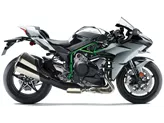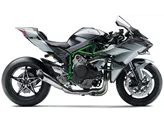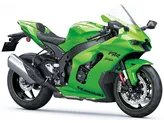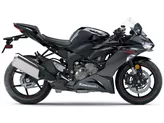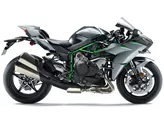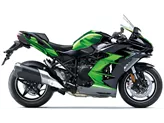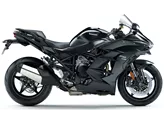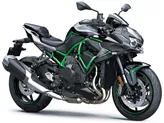Kawasaki Ninja H2 2015 vs. Kawasaki Ninja ZX-10R 2010

Kawasaki Ninja H2 2015

Kawasaki Ninja ZX-10R 2010
Overview - Kawasaki Ninja H2 2015 vs Kawasaki Ninja ZX-10R 2010
The Kawasaki Ninja H2 2015 and the Kawasaki Ninja ZX-10R 2010 are both powerful supersport motorcycles with similar engine specifications. They both have an inline four-cylinder engine with a bore of 76mm and a stroke of 55mm. However, there are some notable differences between the two models.
In terms of engine power, the Ninja H2 takes the lead with 200 horsepower, while the Ninja ZX-10R offers 187 horsepower. This gives the Ninja H2 a slight advantage in terms of acceleration and top speed.
The torque output also differs between the two models, with the Ninja H2 producing 133.5 Nm compared to the Ninja ZX-10R's 113 Nm. This higher torque allows the Ninja H2 to deliver strong pulling power and acceleration.
Another significant difference is the compression ratio. The Ninja H2 has a compression ratio of 8.5, while the Ninja ZX-10R has a higher compression ratio of 12.9. A higher compression ratio generally results in improved engine efficiency and performance.

Kawasaki Ninja H2 2015
In terms of suspension, both models feature adjustable front and rear suspension. The Ninja H2 has a telescopic fork front suspension, while the Ninja ZX-10R has an upside-down telescopic fork. Both models offer compression and rebound adjustment for fine-tuning the suspension setup.
The chassis construction also differs between the two models. The Ninja H2 has a steel frame, while the Ninja ZX-10R features an aluminum frame. The choice of materials can affect the overall weight and handling characteristics of the motorcycle.
When it comes to braking, both models are equipped with double disc brakes at the front. The Ninja H2 features radial technology, while the Ninja ZX-10R has radial and petal technology. Both models offer efficient braking performance and positive ABS systems.
In terms of dimensions and weights, the two models are quite similar. They both have a front tire width of 120mm and a rear tire width of 200mm for the Ninja H2 and 190mm for the Ninja ZX-10R. The wheelbase is slightly longer on the Ninja H2 at 1455mm compared to the Ninja ZX-10R's 1415mm. The seat height is also slightly lower on the Ninja H2 at 825mm compared to the Ninja ZX-10R's 830mm. Both models have a fuel tank capacity of 17 liters.
In terms of strengths, the Ninja H2 is praised for its outstanding build quality, fascinating engine with a mechanical turbocharger, and its ability to deliver exceptional pull, acceleration, and speed. The narrow seat ensures safe standing, even for smaller riders, and the motorcycle offers great stability and inspires confidence despite its high performance. The Ninja H2 also features strong brakes and high-quality details.

Kawasaki Ninja ZX-10R 2010
On the other hand, the Ninja ZX-10R is praised for its extremely precise traction control, efficient braking system, integrated electronics, positive ABS system, and high engine power.
As for weaknesses, the Ninja H2 is noted for its response behavior in the transition from pushing mode to acceleration phase, which is not at the level of "normal" motorcycles. It also exhibits understeer in fast bends, and taller riders above 185cm may find it difficult to integrate their feet into the overall aerodynamic concept.
The Ninja ZX-10R's weakness lies in its suboptimal transmission, which is known for tight gearshifts.
In conclusion, the Kawasaki Ninja H2 2015 and the Kawasaki Ninja ZX-10R 2010 are both powerful supersport motorcycles with their own strengths and weaknesses. The Ninja H2 offers higher engine power and torque, while the Ninja ZX-10R excels in traction control and braking efficiency. The choice between the two models ultimately depends on the rider's preferences and priorities.
Technical Specifications Kawasaki Ninja H2 2015 compared to Kawasaki Ninja ZX-10R 2010
Pros and Cons in comparison
Pros and Cons in comparison
Kawasaki Ninja H2 2015

The Ninja H2 represents a milestone in motorbike history. It is not only packed with electronic innovations, but also offers completely new technologies in terms of engine construction and mechanics. This high-tech research object of a Japanese technology company is actually for sale and can also be ridden. Basically, it rides like a normal motorbike, only with considerably more power. At first, the engine response is a challenge, but speed freaks will find a way to ride and enjoy this fascinating motorbike.
Kawasaki Ninja ZX-10R 2010

Ninja fans have no choice but to buy the new 10. It is lighter, stronger, easier to handle and yet easier to ride than any other ZX-10R to date. Even compared to the other Japanese bikes, the Kawa presents itself as superior. Besides the European bikes, emotions, preferences for certain colours and shapes certainly come into play.
Price Comparison Avarage Market Price Kawasaki Ninja H2 vs Kawasaki Ninja ZX-10R
There are a few key differences between a Kawasaki Ninja H2 2015 and a Kawasaki Ninja ZX-10R 2010. There are the same number of bikes of both models available on the 1000PS.de marketplace, specifically 4. It takes less time to sell a Kawasaki Ninja ZX-10R with 60 days compared to 153 days for the Kawasaki Ninja H2. Since model year 2015 1000PS.de editors have written 27 reviews for the Kawasaki Ninja H2 and 51 reviews for the Kawasaki Ninja ZX-10R since model year 2005. The first review for the Kawasaki Ninja H2 was published on 8/31/2014 and now has more than 5,600 views. This compares to more than 2,900 views for the first review on Kawasaki Ninja ZX-10R published on 1/11/2004.





